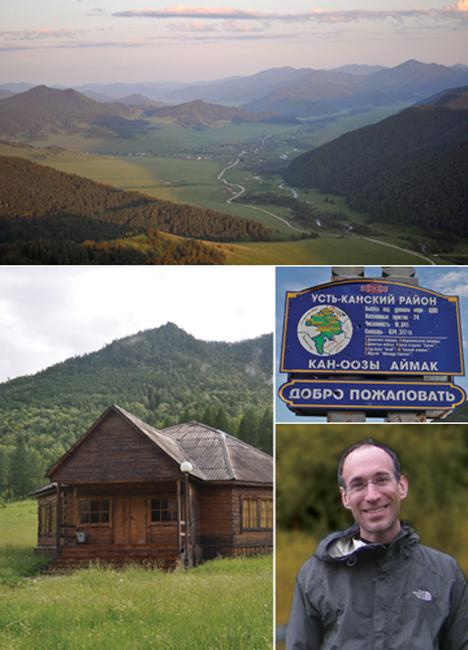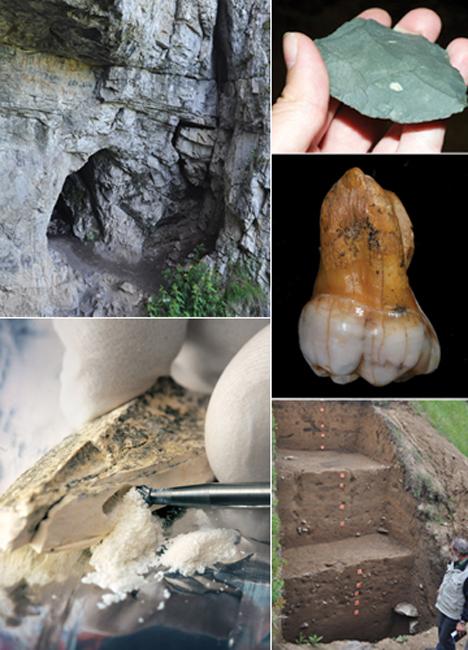Spelunking for Genes
A bone and a molar hold clues to a new branch of our family tree
- Feature

Perched in the Altai Mountains of southern Siberia, and overlooking the Anui River and its surrounding forest, is the Denisova Cave. It is not a particularly large natural structure, but its high ceilings, central limestone chimney, and location near abundant food sources have made it an inviting shelter for humans and animals for tens of thousands of years.
“It’s kind of a magical cave,” says David Reich, an HMS professor of genetics who traveled to the site this past summer. It was a rugged trip, covering 5,500 miles on a 48-hour journey that began in Boston, touched London and Moscow, and finished with a bumpy 10-hour van ride to the Denisova Cave, near Russia’s border with Kazakhstan. But Reich, whose affiliation with the Broad Institute of MIT and Harvard means he’s more often surrounded by gene sequencers than Stone Age tools, took the opportunity to step inside this remote refuge to witness the resting spot of ancient DNA that had been preserved in bone fragments buried deep in cave sediments.
For the past year, Reich and an international team of evolutionary geneticists have been coaxing information from that DNA. What they’ve found has changed our understanding of human history.
Welcome to the Family
Russian archaeologists have been excavating Denisova Cave for three decades, but it wasn’t until recently that they unearthed a pea-sized pinky bone from a young girl who, they think, lived some 30,000 to 50,000 years ago. Remarkably, it contained enough genetic material to salvage and study.
That bone, along with an oversized adult molar, helped Reich and his colleagues at HMS and the Max Planck Institute for Evolutionary Anthropology in Leipzig, Germany, identify a previously unknown hominin who was neither Neanderthal nor modern human. This “archaic” group, dubbed the Denisovans, after the cave, apparently inhabited a large swath of Asia and—like Neanderthals—mated with modern humans. Although both Neanderthals and Denisovans eventually died out, traces of their genes live on in some populations today.
These discoveries are adding pieces to the puzzle of how humans evolved and where and when prehistoric people roamed the Earth. The work also reinforces the notion that population mixing has been the rule, not the exception, throughout human history. For geneticists like Reich, however, the greatest promise of this research might be in learning whether the genes inherited from these ancient people help protect today’s humans from disease.

With the aid of super-fast sequencing and genotyping equipment, the field of modern genetics is expanding knowledge about the past at whirlwind speed, and Reich is at the forefront of that transformation. He and his HMS bioinformatics team have developed complex statistical algorithms for analyzing gene-flow patterns—in this case, for comparing the genomes of ancient and present-day people. “This is an incredibly exciting time to be doing this work,” says Reich. “There’s a lot more data than people can make sense of—and the data keep getting better.”
Going to the Source
Journeying to Siberia gave Reich a chance to put in context his research on the DNA from that young girl of long ago. He was among a group of 20 geneticists, archaeologists, and paleoanthropologists from the United States, Asia, Europe, and Russia who gathered for the express purpose of learning more about this newfound branch of the human family tree. Although researchers have measured the Denisovans’ genetic footprint, they don’t have any full skeletons to reference. “Neanderthals are extremely well characterized in the fossil record,” says Reich, “but these guys are not. It’s DNA in search of a fossil record.”
Denisova is so important archaeologically that the Russian Academy of Sciences operates a permanent camp with meeting spaces, a dining hall, and huts with plumbing. A summer visit is definitely the wiser move, though: Winters are frigid, but summers are verdant and temperate.
The group shared findings, visited a dozen archaeological digs, and enjoyed hearty dinners punctuated by vodka toasts. But the highlight for Reich was spending time in the Denisova Cave. According to Russian sources, the hideaway is named after a hermit, Denis, who called it home during the eighteenth century. From their study of the bones and artifacts excavated from the cave, scientists think that Denisovans, Neanderthals, and modern humans all took refuge there at some point. “We don’t know any other place where all three groups lived,” Reich notes. “That fact gives me a strong sense of continuity with the past.”
Where the Bones Are Buried
Archaeologists have dug through 22 layers that step through time from 280,000 years ago to the present. Large objects are bagged, and samples placed in buckets and slid down a wire to a sifting station across the Anui River. That attention to detail led to the unearthing in 2008 of the pinky bone. It was found in layer 11, a meter-thick stratum laid down over at least the period from 30,000 to 50,000 years ago. In addition to the finger bone and the molar, layer 11 has yielded a Neanderthal toe fragment and a trove of tools and jewelry associated with modern humans.
Reich’s involvement in the Denisova project is a bit of scientific serendipity. Svante Pääbo of Leipzig’s Max Planck Institute was heading up an effort to decode the Neanderthal genome from bones found in Croatia, and had invited Reich; Nick Patterson, an HMS genetics research fellow; and others to join. The team’s findings had just been published in Science in May 2010, when surprising news came from Germany.
“The Leipzig group constantly screens material from various archeological sites,” Reich says. “They were screening bones from the Altai Mountains site and noticed the teeny finger bone. I’m shocked that people even knew it was a human finger bone.”
The shocks did not end there. After painstakingly drilling into the bone and grinding up the extract, the investigators learned it contained an impressive amount of genetic material, both mitochondrial and nuclear DNA. Reich’s team studied the ancient genome’s nucleotides, along with DNA sequences from a molar recovered from the cave, and realized the sequences were related to some sequences in Neanderthal DNA.
“We know it’s not a Neanderthal because all Neanderthals are quite closely related genetically. This was a very distant relation. It’s actually a sister group to the Neanderthals.” Their analyses also revealed that Denisovans bred with the ancestors of present-day New Guineans and other Melanesians. This discovery led to the team’s second much-heralded paper of 2010, that one in Nature in December.
Delving deeper into the data, the team found that Denisovans lived across a vast area that ran from southern Siberia to Southeast Asia, and that they contributed genes to several populations in Southeast Asia and Oceania, including Australian aboriginal peoples. Interestingly, however, the researchers did not find genetic traces of Denisovans in other groups in this region, including mainland Asians. These findings, the scientists note, suggest that modern humans settled Asia in more than one wave of migration.

Scholars have long debated what happened when modern Homo sapiensemerged from Africa 50,000 or more years ago. The work of Reich, Pääbo, and their colleagues offers some insight by indicating that those early humans mixed with both Neanderthals, who inhabited Europe and the Middle East, and the Denisovans in Asia. In fact, the scientists found that today’s non-Africans inherit 2.5 to 7.5 percent of their DNA from Neanderthals and Denisovans.
Vintage Accessories
The medical benefits of this research have yet to be fully fathomed. Our Stone Age forerunners passed on traits that modern humans may have used to adapt to new environments, says Reich.
“It will be exciting to see if and how these variations had consequences for disease risk as well,” he adds. A study by Stanford University scientists who examined the genomes suggests that Neanderthals and Denisovans helped boost the immune systems of future generations by contributing alleles associated with the human leukocyte antigen system, which helps the body recognize disease-causing germs.
Practical matters aside, Reich finds these pursuits intellectually and personally satisfying. “I feel that part of being human is to be curious; to learn about who we are, where we came from, and the nature of the world we live in,” he reflects.
Near his desk in his Boston office, Reich keeps a clear plastic box. In it are two small cream-colored casts, one of the Denisovan pinky bone and the other of a molar found in the cave. They are tangible reminders of the ancient people who inspire his very modern work.